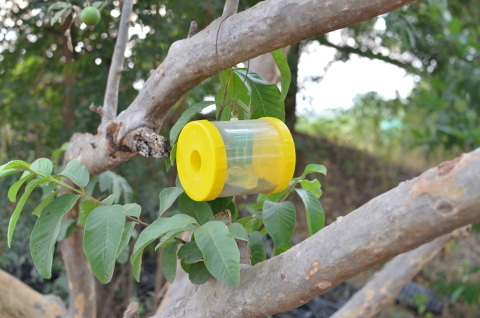
Protecting crops from pests and diseases is the biggest challenge in organic farming. We use a variety of methods and techniques to manage pests and use no synthetic chemical pesticides of any kind. We believe synthetic chemical insecticides and fungicides pose the biggest risk and are the biggest chunk of the problem to be eliminated in producing safe food.
Pests that damage crops are largely insects, mites, nematodes and rodents while diseases are caused by fungi, bacteria and viruses. Some of the methods we apply to manage pests and diseases are listed here:
Crop rotation
By rotating crops in time and space, we break the continuum of pest life cycles. By growing a different type of crop in a plot that was used to grow a certain crop in the last season, we prevent the pest of the last crop to merely emerge, find ready food to run another life cycle and thrive. Similarly we avoid growing the same crop continuously to create breaks in the pest incidence.
Field sanitation
We make sure pest infested materials are removed promptly. For example, leaving fallen fruit infested with fruit fly lying around lets the adults emerge from the fruit and infest fresh fruits. We eliminate infested plants and vegetation so as to restrict spread of the infestation.
Physical protection
We physically protect plants and fruits where appropriate. Our nursery plants are protected by a mosquito net that prevents attack on the tender plants by insects. When we find fruit flies during a season, we physically wrap the fruits in paper or polybags to prevent damage by the insects – yes, it is very labour intensive and time consuming.
Trap and companion crops
If you find our farms dotted with marigolds and castor, it is not so much to beautify the gardens but to have attractant/trap plants that divert insect pests from attacking the main crops. If you then see our muskmelon plants growing amidst a bunch of radish or garlic plants, it is our companion crops strategy at work where one plant beneficially influences another, mainly by repelling the pests that otherwise attack the plants.
Natural enemies and predators
By not using synthetic chemical pesticides, we let nature’s checks and balances on pests to come into play over time. Most pests get controlled to reasonable levels in nature by a population of natural enemies and predators of the pests that adjusts itself to pest population. For example, an increase in aphid (pest) population results in an increase in ladybird (predator) population that then checks the aphid population. Birds, lacewings, spiders, preying mantids, wasps, lizards are all natural pest controllers that help us control pest levels naturally and safely.
Light, Food, Pheromone & Sticky traps
We use pest specific attractant traps that are based on light, protein baits, pheromones, color etc. to help us monitor and manage pest populations. To illustrate, we use light traps to control brinjal borer moths, pheromone traps for male annihilation of fruit flies (on fruits & vegetables), pheromone traps to monitor Helicoverpa, Spodoptera & Leucinodes arbonalis outbreaks and sticky traps for aphids & thrips.
Mechanical & Manual control
We have had an innovation of putting an electronic mosquito swatter bat to good use to manage cucurbit beetles and blister beetles. Similarly we sometimes resort to picking and eliminating some insect pests and infested plant parts, however labour intensive it is.
Biological agents and biopesticides
We employ a range of beneficial biological agents – largely bacteria and fungi – either as soil or foliar applications to manage pests and diseases. Trichoderma viride and Pseudomonas sp. help control a number of fungal infestations in plants, Bacillus thurungiensis kurstaki, Verticilium lecanii, Metarhizium anisopliae are some of the microbial agents that help us keep in check specific insect pest types.
Plant extracts & concoctions
We apply a range of plant based concoctions, neem extracts, neem cake, preparations such as neemastra, brahmastra, agniastra etc. for control of pests and diseases. While some of these are commercially procured, most of them are prepared on farm.
Cow based preparations
We prepare desi cow based preparations such as Panchagavya, Jeevamruta, Beejamruta on the farm. These are used as natural pest management sprays and also double up as fertility enablers.
Natural pest management materials
We also apply a number of natural pest management materials such as diatomoecious earth, kaolin clay and plant based pyrethrum time to time. Among the naturally derived materials, we identify the materials noted as safe and permitted for organic farming and put them to good use.
In spite of using all the above methods, sometimes pests emerge strong in certain seasons and we lose the crops. We see it as a part of the cycle and plough down such crops but do not give up on recropping.
More on our farm management
Soil Management at NaturePinks
Pest Management at NaturePinks